Hiss in Cuffs
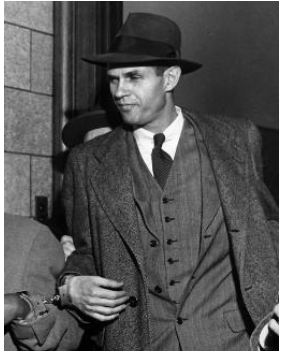
(State Department Official and Soviet Spy Alger Hiss in handcuffs. He dined out on his innocence for decades after. Photo AP.)
I was sitting with Mac last night at Willow. We are trying to get him out when he
feels up to it, and he is, of course, a rock star to the Regulars at the Amen
Corner.
I did not take notes. My leg is bothering me still, and we talked about the future
rather than the past- plans for the 70th anniversary of the Battle of Midway, and
whether or not we should wear tux for the Ball (Mac will not).
We managed to get Liz-with-an-S in trouble with management along the way- I won’t go into the intricacies of the restaurant business, except to say that we should have balanced our relations with Labor and Management less effectively. It is a delicate balance, and the value of labor always has to be balanced against the essential energy of those sweat has made the work possible in the beginning.
It doesn’t always balance that well, and it is important to keep the lines of
communication open. So, in the interest of that, I am going to keep my mouth shut about whether or not certain industry events get a little confused on the concept of whether an “open bar” means a “no tip” bar for people who are making $2.13 an hour.
“I made more than that on the loading dock in 1966,” I said.
The waitress was in mufti- on the civilian side of the bar for a change- and she
shrugged. “We work for tips. The rest of it just goes to cover the social security
and Medicare.”
It is enough to make you feel like a fellow-traveler in solidarity with the workers
of the world, you know?
We wound up with a great crowd at the bar- Senior Executive Jeff and John-with and Jon-without, and Old Jim and the other usual suspects. Mac had exactly two Anchor Steam beers, and I had about enough happy Hour White to navigate on my cane to the Bluesmobile parked at the curb down the block.
Of course, talking about the present lead right back around the rosebush to the
past. We talked about Mac’s return to Hawaii as we discussed arrangements for
lodging in the future, commingling the atmosphere of the pleasant islands against
the backdrop of wars against the Empire of Japan and the later one against the VC and North Vietnamese Regulars.
Mac had been the Pacific Fleet Intelligence Officer (N2) in the mid-sixties during
the big uild-up in South East Asia, and he described (a little wistfully) how he and
his wife Billie would get a room at one of the grand hotels to stay over night while
attending social events over in Honolulu or Kahala. “We used to do the same thing,” I said. “It made you feel a little like a well-heeled tourist rather than a staff
puke at the Headquarters.”
Somehow the Health Care arguments before the Supreme Court came up in passing, since it affects all of us, not just those of a certain age, and Mac vowed that he was going to make the century mark. That lead in a round about matter to a discussion of the role of the Judicial Branch in the ‘separation of powers’ scheme of our topsy-turvy government.
Say what you like about the Court- mostly invisible, the SCOTUS has a direct and
sometimes startling impact on the rest of our sprawling government. Remember Bush V. Gore? And they may be at it again with the Affordable (or not) Health Care Act’s constitutionality.
“The Government could not come up with a defining reason for why it could not force
us to buy Broccoli,” said John-with. “It is about liberty.”
“I am uncomfortable with the whole green vegetable mandate,” I said. “But all
President’s have had problems with the Supremes. Remember FDR and packing the Court?”
Old Jim pursed his lips. “The Judicial Procedures Reform Bill of 1937 would have
added more associate justices to the High Court. That was FDR’s scheme to pack the court with New Deal sympathizers to approve legislation that had been declared
unconstitutional by the mostly Republican-appointed court.”
“Yeah,” I said. “Court-packing. The constitution doesn’t specify the number of
judges, and FDR wanted the authority to an additional Justice, up to a maximum of six, for every sitting member over the age of 70 years and 6 months.”
“That is not so old,” said Old Jim, taking a swig of Budweiser.
“All things in perspective,” said Mac. “That is positively youthful.”
“There was quite a sea change in Washington in those days. I wrote a series of
stories about the neighborhood around Big Pink. The Buckingham housing development and the others along Route 50 were created to house all the New Dealers who were coming to town to fix the Depression.”
“That is not the only bunch who came to town. So did the spies.”
Mac came back to DC from Hawaii in 1946, and transferred to the Restricted Line- Special Duty Intelligence. He married Billie here, and served for a year in the
Pentagon and at Foggy Bottom as an editor on the Diplomatic Cable, a summary product of the War Department, Navy and State. Then he got a transfer to London and Naples, and had some excellent adventures in the opening days of the Cold War in Europe.
“The Diplomatic Cable was composed from the intercepted communications of the embassies, right? Did it include the VENONA information?”
Mac shook his head. “No, that stuff was too sensitive. Army Chief of Staff Omar
Bradley kept the lid on that stuff pretty tight.”
“What was Venona?” asked Jon-without, adjusting his bow tie. We had also been
talking about how he kept the black caps on his well-crafted shoes with such an
authoritative gleam- his description of the old t-shirt rags and black polish
reminded me of Aviation Officer Candidate School, and my vow never to have a highly polished gleam on any shoes I owned since.
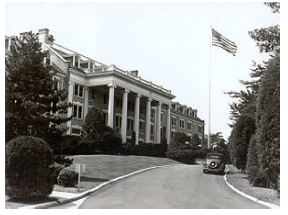
(The Headquarters Building at Arlington Hall. It is still there, though they don’t do codes there any more. Photo US Army.)
“VENONA was a break in Soviet diplomatic cables,” said Mac. “The Army did the work
at Arlington Hall, across from where Vic lives. I do not have time to delve too
deeply into the Sources and Methods aspect of VENONA. That was just the last
codeword for a dozen exploit programs that took advantage of a flaw in the Soviet
communications system. They re-used some of the cyphers contained in one-time pads
due to the exigencies of an expanding war in the East. Only the years between
1942-44 yielded much data, though the files were worked all the way up to 1980
before cryptologic resources were moved on to more pressing issues.”
“Those were the ones that had the names of all the Soviet Agents in the US
Government,” I said. “It was political dynamite. That is how they got tipped to the
Rosenberg atom spy ring at Los Alamos.”
Mac nodded. “What we did on the Diplomatic Cable did not include that material. Our
produce was the lineal antecedent of what you guys call the National Intelligence
Daily.” He paused in thought. “The VENONA matter was an uncomfortable one for
everyone. The true names of the Soviet agents were not in the cables, only code
words, so there was a little ambiguity. They were afraid it would all be
inadmissible in court, so they sat on it.”
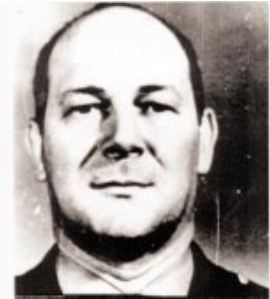
(Bill Weisband in uniform. He was a great guy, well-liked by his Arlington Hall co-workers. Photo US Army).
“Yeah,” I said, taking a sip of Happy Hour White. “The Soviets were tipped to the
matter fairly early on- the bulk of the successfully decrypted messages were
harvested only up to 1945. An Army officer named Bill Weisband, a native of Odessa,
was the mole who probably disclosed the success of the operation to his handlers in Moscow.”
“Asshole,” said John-with.
“Yeah, he never faced the music for what he did. Died of a massive heart attack on
the George Washington Parkway. Sold insurance after they eased him out of Arlington hall. He never stood trial.”
“Most of them didn’t. It was too explosive,” said Mac. “Weisband was born in Odessa, and his Russian was flawless. He had access to all areas of Arlington Hall’s Soviet work, including the Western atomic scientists who cooperated with the Soviets at least as early as 1944.”
“And Alger Hiss,” I said. “That asshole.”
“That was quite the controversy in the day- him and Whittaker Chambers and the
Pumpkin Papers.”
“Hiss had his defenders all the rest of his life. The trial of the century is what
they called it when they tried him for perjury.”
Mac nodded. “It was not until the KGB files opened up briefly in the early 1990s.
That is what nailed him as a Soviet Agent almost conclusively.”
“The ambiguity of his guilt became a litmus test of political views, since the very
basis of evidence was likewise ambiguous. Senior army officers, in consultation with
the FBI and CIA, made the decision to restrict knowledge of VENONA within the
government. Army Chief of Staff Omar Bradley was concerned about the White House’s history of leaking sensitive information.”
“Yeah,” I said. “Harry Hopkins was fingered as a mole, and he was at FDR’s shoulder the whole war.”
“To some degree, Bradley’s decision to keep the VENONA material secret was
counter-productive; Truman was distrustful enough of J. Edgar Hoover, and suspected the reports of Soviet penetration were exaggerated to obtain political leverage for the Bureau.”
“Enter Tail Gunner Joe, and Dick Nixon and Ray Cohn the great Communist witch-hunt.”
“It is only a witch hunt if there aren’t witches,” I said. “There really wasn’t any
organization in town here that wasn’t penetrated. It was amazing.”
“Still controversial in some quarters,” said Old Jim. “I met Bill Kunstler one time,
the hired legal gun of the ’60s radicals. One of his last great quotes was after the
Moynihan Commission on government secrecy reported out with all the VENONA
revelations. Kunstler claimed the Army had forged the whole project to discredit
honest Americans.”
“He was another asshole,” I said. “I remember him well.”
John-with snorted. “That was back when things were harder and they had to steal
secrets the hard way, by human agent.”
“Yeah, you are right,” I declared, draining my glass of wine and covering the top
with my palm when Liz-S attempted to fill it up again. “Now the Chinese just hack it all without having to leave a computer terminal in Guangdong Province.”
“Sort of makes you homesick for the old days,” said Jon-without.
Mac shook his head. “Not so much,” he said. “Just think of Alger Hiss in handcuffs.”
Copyright 2012 Vic Socotra
www.vicsocotra.com
Es Kommt Der Tag

The day is coming, not like we have much choice. I was easing into it as I got an early call on the cell phone. Dawn was creeping in around the building, flanking the shadows that hang down long from the towering flat roof. I hide from the first light on the west side, by the pool, and watch it illuminate the crenelated tower of the Culpepper Gardens Assisted Living Facility where I vote and may wind up someday if I don’t play my cards right.
The dawn’s early light is something on which I can take a pass, though it is gratifying that the darkness is giving way to light, earlier and earlier.
The call was one of distant early warning about business. I try to avoid talking about work in these tired chronicles, but there is something that is looming, and has been for a long time. It has been sitting on my shoulder like a drunken parrot, or the surly elephant in the corner who would really like another load of peanuts.
Here is the deal: we submitted a big proposal for a ginormous government contract last October. We did pretty well on the predecessor vehicle, so I have been cautiously optimistic that we would secure a place on the follow-on contract. It has been so long since we submitted- almost six months- that the whole thing has assumed a sort of surreal aspect. Like when my firs born was late by a couple weeks, and I just assumed that the pregnancy had become some sort of permanent condition. I would hate to think the Government has no idea what it is doing, and that the whole enterprise is creaking to a halt.
That could be no more possible than stopping the dawn, right
This week, the birds have been chirping that it might be Der Tag- the day of award.
There are several practical and personal implications of the binary choice the government will make. We either win a place at the table, or we dont. I cant really get beyond the branches-and-sequels of the decision.
If it is the former, life is going to be exciting. The chance to bid on work will come with intense pressure, short turn-around responses, and the thrills and chills of capitalism. Also, an end to weekends-off for the foreseeable future, just as it was for more than a year when we won a Prime role on the original contract.
If it is the latter, wellthere could be much more time off than anyone wishes.
Regardless of what happens, someone will have bruised feelings and there will be a formal protest that will hang things up. At least we will know what we are confronting.
I dont, at the moment, and have to go on planning for success, since doing the reverse- not planning will ensure failure. Consequently, I have a presentation to give out in the wilds of Fairfax County and will strap on the leg brace and try to navigate out there with the hairs standing up on the back of my neck.
Before succumbing to the pleasures of the working day, I attempted to digest what may (or may not) have happened in front of the Supremes in Day Three of the oral arguments about the health care train-wreck.
The note from AG Ken this morning said it appeared to be a skeptical bench in the morning session (impact of severing the Individual Mandate on the Act as a whole), and pro-Administration in the precedent of the Congress being able to bludgeon the several states with the withholding of grant money.
We wont know the answer until June, which is when all things will be revealed, and with luck, I will know about the outcome of the Ginormous Contract. Maybe even today.
It is a week filled with wonders, and it is not even close to being over.
Copyright 2012 Vic Socotra
www.vicsocotra.com
Slap Down

(Jon-no-H proudly displays his hometown pride on the way to watching them bury the Caps, 5-1. Photo Socotra).
I took my sweet time getting onto the stool at the Amen Corner. I put the cane away. It fell with a clatter. I took off the leg brace and tried to hang it up on the little hook the women use for their purses under the bar. It fell in a pile on the floor next to the cane. I waved at both with frustration. Old Jim growled at me: “Didja vote?”
“I was lucky to get in the shower this morning,” I said, unstrapping the brace from my leg. I have been wearing it over my trousers of late, since I have to get the cursed thing off periodically or the whole extremity goes numb if I leave it on. “I have to wear this thing even when I am under the water.”
“Or else you fall down?”
“Yeah, drowning death is not the way I want to go out.”
“We all go out,” he declared. “That is the only thing certain. No one is unique. That and burial, of course.”
“And the fact that the Democrat is going to win the County Council Special Election,” said John-with-an-H. He was drinking the Happy Hour Red, me the White, and Old Jim the classic Long-neck Budweiser.
“Crap,” I said. “That is three unique things. I forgot to vote on the way to work this morning. I made a mental note and it got erased some place along the way. I must have been thinking about dropping the old television at the Goodwill on the way in.”
“How are you going to do that with the gimp leg?”
“Hope that they have some big guy to help me unload it,” I said a little defensively. “It was a good TV- just not internet-connected. I could never figure out how to hook the computer up to it.”
There was a commotion at the door, and into the dim light of the Willow Bar came Jon-without-H. He was dressed for a sporting event, open collared shirt with trademark no bow tie and proudly wearing a Buffalo Sabers sweater, completely authentic with the ‘CCM’ label affixed prominently to the hem.
“Well, lookie here,” said Old Jim. “A proud Sabers fan!”
Jon-without looked a little sheepish in the public display of his resolve to supporting his home-town team against our local Russians. “Well, yes. It is time to bring out the colors.”
“You going to the game?” I asked.
Jon-without nodded. “Tip off at seven PM,” he said. “I can only stay for two,” he signaled to Liz-with-an-S for an iced tea and vodka. Liz is all about efficiency, and the pale brown highball appeared in front of him in a glimmer of reflected light from the fading sun shining in the plate glass window on the west side of the bar.
“Tip off?” growled Jim.
“Your sweater could turn the whole thing around,” I said.
“It might. Ovechkin has been on a tear for the Caps. They are tied in points for the Cup Playoff. If the Sabers can stop him, they will go two points up with just five games to play in the regular season.”
“Good luck,” I said. “When do the polls close?”
“Seven, same as the first pitch at the hockey game,” said John-with.
“Damn,” I said, “I am going to go when Jon-without does. I don’t want to miss the chance to vote against someone.”
“Who is that going to be?”
“Dunno. I didn’t get much in the way of voting for Daffy Duck the last time. Maybe I will go with the Rabbit.”
“Good. Just don’t through away your vote,” growled Jim. “I think the rabbit has a lot going for him.”
I strapped on the leg brace and walked out when Jon-without felt that he had to be headed for the Metro. “See you tomorrow, Gentlemen,” I said, careful about putting weight on the leg. I did not try to keep up with Jon, who moved gracefully through the crowd on the street like Sabers Right Wing Jason Pominville on a breakaway.
I tapped my way to the Bluesmobile. No one had broken into the car to steal the old television in the back seat, and I resolved to do something about it real soon.
I wheeled up to an empty space in front of the Culpepper Gardens assisted living facility where the polling station is located in a wide wild turn across the left lane. I had minutes to spare, which was useful, since getting out of the car requires a certain pretzel logic with the leg brace. I tapped my way down the sidewalk behind an old woman with a walker who was being helped by a couple who might have been her kids.
When we all arrived at the registrar’s desk, there was an elderly man there who was very confused. He wanted to vote, but did not know where he was registered. There was quite a discussion about that, and eventually I proved my existence to their satisfaction and handed me a voter card. There was no line for the two electronic voting machines, and I waited as the volunteer turned the key to allow me to exercise the franchise.
I leaned heavily on the cane, since it looked as if I put too much weight on the machine it would collapse. I did not want that to be a metaphor, so I was extra careful.
I paged through the menu and saw three names on the ballot, none with party affiliation. “Crap,” I thought. “I should have taken the voter guide from the homeless guy out front. How do I know who to vote against?”
I scrolled back to the write-in page and tapped in the formal name for the Rabbit. I looked at it for a while, and then scrolled forward and looked at the three names that probably were real human beings. I tried to remember the two I wanted to vote against, and took a chance. I hoped I had voted for the candidate who could do the least amount of harm to me. Then I pushed the bright red button that said: “Vote,” and got my sticker from the nice volunteer that proclaimed I had participated in Arlington’s electoral process.
I thanked everyone for their service, and weaved back up the sidewalk and out to the police cruiser.
The sun was just setting when I finally made it up to the unit. I turned on the hockey game and caught up on email while sipping a tall vodka-on-the-rocks. There was a note from my pal Ken, the Commonwealth AG. He wrapped up the arguments on the second day of Health Care argument before the High Court.
Ken claims that there are severe matters of liberty at stake. By implication, he wrote, the Justices seemed, on balance, to be concerned that if we can be compelled to purchase health insurance, then we can be compelled to buy all sorts of things.
Apparently broccoli came up again a couple times. I sighed. I like broccoli, at least mildly blanched and bathed in a delicate cheese sauce. But suppose the Government decided to make us all buy Chevy Volts?
The Solicitor General claimed that was nonsense, since Health Care is completely unique, and the only thing we all need to have at some point. I sort of agree with that, though I find the implications troubling in the extreme. I don’t want to own an electric car, and if I don’t feel like broccoli, I don’t think it is Washington’s place to tell me that I have to.
But Health Care is unique, right? This is special and could never be expanded into other things, right?
I had to laugh when I got most of the way through Ken’s note. The Justices really are funny people. Associate Justice Alito noted. He is really a cut-up on the bench, a regular rascal. The Solicitor General seemed sort of cross with him.
Alito said: “burial costs are expensive, and could hit one unexpectedly as well. Suppose I was too poor to pay my own costs, and hadn’t prepared for my burial. I will still get buried, and those costs will in turn be shifted to others, either by raising everyone else’s burial costs, or in higher taxes if the government has to bury me.”
I glanced up at the new TV, the non-high definition coverage of the game a little blurry on the enormous screen. As it turned out, the Sabers buried the Caps, 5-1, and it might have been Jon-without’s Buffalo sweater that turned the tide.
Couldn’t have been anything else, right? It was unique.

(Caps #8 Alex Ovechkin works the puck around Sabers #24 Robyn Regehr during the third period at the Verizon Center last night at The Phone Booth downtown. The Caps still got smacked, 5-1. Jon-without is just to the upper right. Photo by Rob Carr/Getty Images).
Copyright 2012 Vic Socotra
www.vicsocotra.com
House Calls

(Remember Harry and Louise? Concerned Citizens at the breakfast table.)
Virginia Attorney General Ken Cuccinelli sent me a nice note this morning. Well, better said, his gubernatorial campaign sent me a note about the first day of hearings in front of the Supremes on the Affordable Health Care thing.
The Virginia Governor is a term-limited position- the Old Dominion is unique in prohibiting its chief executive from succeeding himself, though the incumbent is free to run again for the office after four years out of the executive mansion. Accordingly, we have a long line of politicians using the gubernatorial post as a sort of gateway drug to something else.
Cuccinelli was in court for the opening day, and his campaign is using his notes of the proceedings as a commentary on his view of government. The current Republican governor, Bob MacDonald, is still smarting from the backlash over the antics of his co-party legislators on women’s reproductive rights. He had to back-pedal pretty hard when it was revealed exactly what the new pre-abortion screening process was going to entail, and he is obviously looking forward to his net elected position, as is his Attorney General, who is a high-profile litigator in all sorts of things that would not readily jump to mind.
It is sort of like when Mr. Obama came to Washington amid the economic melt-down, through $800 Billion out the windows of the White House to follow Mr. Bush’s $700 Billion bail-out and declared the number one issue before the reeling United States to be…
Yeah, Health Care. You might want to look up Ken’s commentary on Day One, since it outlines one of the aspects in which the largely un-read and weirdly structured legislation is based. I found the full text on a Tea Party site, not that I endorse it, but they posted it in full, and it is worth a read, with a grain of salt, since it is part of the framing of his political campaign.
http://www.richmondteaparty.com/2012/03/supreme-court-healthcare-hearing-day-1-summary/
I take all of these guys with at least a grain of salt, if not a full handful. That goes for the other side on this thing as well. I am deeply troubled by the notion that the government is about to mandate my purchase of asparagus and whether or not I eat my broccoli. Or something. But the issues are indeed interesting, and if you don’t follow them, well, be prepared for all sorts of exciting new mandates from people who seem very comfortable in telling you what you must (or may not) purchase in the marketplace.
When is a penalty a tax, and what is a tax, anyway? That was the subject of Day One in a nutshell, but I was out in front of that, favoring a single payer system, and that got some folks all riled up. The Justices are doing this the methodical way. They heard first things first, and that starts with the Anti-Injunction Law and the argument about whether “penalties” for not buying health insurance should be considered a “tax.”
If they are a tax, the law says arguments against them can’t be heard until they are actually paid, effectively meaning the whole case on the constitutionality of the law would have to be postponed.
The internet was out at Big Pink when I got up and hobbled back to the kitchen for coffee and then plopped down at the dining table to find out what had happened overnight. “Crap,” I said, as the long queue of messages appeared, flickered, and was gone. I won’t trouble you with my wifi challenges- my base station has lost its encryption and needs replacement- and hence, I had to go down to the editorial offices of The Daily at Socotra House to log on.
There was a knot of people out front with signs and surly attitudes. The building had been egged, and some scruffy-looking folks threatened to block access to my place of business, or opinion, as the case may be. When is the exercise of free speech an act of intimidation? It all depends on what office you are trying to get into.
Anyway, I did get a chance to read Mr. Cuccinelli’s opinion, and had a mildly positive view of the Supremes when I got done. To continue Associate Justice Thomas’s basketball analogy of a few weeks ago, there appeared to be no “slam dunks,” in the arguments.
Today is supposed to be the big day, and we will just have to see how that goes down.
But as to the protests about the whole single-payer thing, I think it is useful to look back and see how we got to the place we are, with most people’s health care provided in symbiosis with their employers, and whether or not that arrangement is enshrined in the Constitution.
It is not, of course. In fact, it is one of those legacies of chance and circumstance that defines our patchwork Republic.
There was no such concept as “health insurance” when the founding documents of the nation were drafted, much less the idea that such a thing might be an inalienable right. The first “accident insurance” did not appear until 1850, and offered a chance to purchase protection against injuries suffered in railroad and steamboat accidents. Competition- a feature much sought after to incentivize competitive pricing- soon was a fixture of the new industry with over sixty companies offering insurance policies by the end of the Civil War. Think, for a moment, of the number of veterans with grave injuries (suffered for the nation, or against it) which would necessarily be considered “pre-existing conditions.”
Boggles the mind. That whole generation had largely passed away by the time the first experiment in a disability policy was issues in 1911, but the orientation was not on medical coverage, but rather covering lost wages, since everyone was expected to pay for the Doctor’s services on an out-of-pocket basis, or what we call now the fee-for-service business model.
The orthopedic Surgeon up the road from Bib Pink was happy to offer me that option last week when I could not walk, and was not entirely sure I could navigate myself to my primary care physician over in Bethesda.
Hospital and medical expense policies were introduced during the first half of the 20th century. During the 1920s, individual hospitals began offering services to individuals on a pre-paid basis, eventually leading to the development of the Blue Cross organizations after the Great Depression started in 1929.
That is the deal here- Blue Cross was a private deal, between the company and the insured. I heard some muttering in the crowd that it was Socialism, and that it could not be countenanced. That got me going. I despise Socialism and Socialists, for that matter, and their resurgence after the fall of Communism is something that I look at in baffled wonder. I mean, it didn’t work for Russia or the Soviet Bloc, so why do they think it will work this time?
But I have to say, we got a sort of Socialism with the New Deal, and people have been bitching about it ever since.
Here is my point about all that. The Roosevelt Administration is directly responsible for the system we have now. Blue Cross before World War II was a private deal, though it could be encouraged by a partnership with Industry. With the titanic mobilization of just about everything to destroy Fascism, wage controls were put in place to ensure there was stability in the skilled work-force, and people could not hop from job to job, effectively making themselves small-scale war profiteers, something that was once considered bad form.
As I have often told my sons, when they would listen, that the value of labor is the key to understanding politics. The War made the labor market tight due to the increased demand for goods and decreased supply of workers during the war. Federally imposed wage and price controls prohibited manufacturers and other employers raising wages high enough to attract sufficient workers.
The major tipping point was an exercise in social control by Washington: the War Labor Board, an unelected (but quite efficient) group determined that fringe benefits (including sick leave and health insurance) did not have to be counted as “ordinary income” for the purposes of wage controls, employers responded with significantly increased benefits. Unions have been negotiating contracts on that basis ever since- and hence the “cadillac” health plans of which people are so fond.
Voila! Between 1940 and 1950, the total number of people enrolled in health insurance plans grew from 20,662,000 to 142,334,000. By 1958, 75% of Americans had some form of health coverage.
I could hear eggs hitting the side of the building with dull thuds. When I looked out the window, I could see some people putting up tents in the square across the street. I opened the window and shouted down: “Hey, it already is socialism! It always has been- it is a relic!”
I plopped down on the ergonometric chair by the big walnut desk and sighed. “If only Bush had made it possible for the VA to negotiate the price of drugs, then maybe Medicare Part B would not have been just a ruse to provide vast profits to Big Pharm.”
I lit up a Lucky, thinking that the risk factor would probably make me ineligible for most surgical procedures under the new Affordable Care Act and the rationing of services that is inevitable in a vastly expanded public health care system. Of course it is socialism, I thought.
But it already is.
“Shoot,” I muttered. “Every President has struggled with this one, from harry Truman on down. Dick Nixon slugged it out with that windbag Ted Kennedy about it. Fat Ted wanted a single payer system, and Tricky Dick countered with a proposal based on mandates and incentives for employers to provide coverage while simultaneously expanding publicly-run coverage for low-wage workers and the unemployed.
That hybrid system might have worked, but Watergate got in the way, and the Oil Shock and all the rest of the disasters of the 70s. Clinton tried it, too, as we all recall. Remember Harry and Louise and their concern that the government would come between them and their physician? Shoot, the government has been there for seventy years. The question is what kind of socialism you want, or better said, what we will put up with.
That is why day two at the Supreme Court is going to be interesting. Or at least one of the reasons. I just want those people to get away from my door. My leg hurts, but I guess that doesn’t matter.
The Doctor doesn’t make house calls anymore anyway.
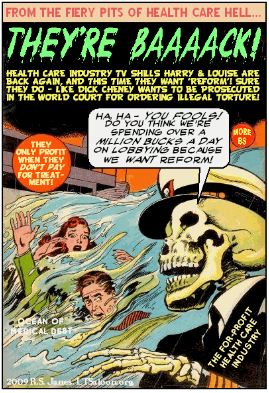
Copyright 2012 Vic Socotra
www.vicsocotra.com
QALY and the Court
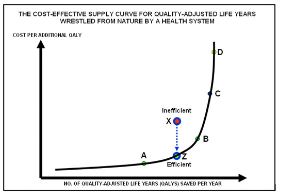
(See? It really is as easy as pie. The solid, upward-sloping supply curve means that any point on the curve represents the least expensive medical treatment capable of producing additional Quality-adjusted Life Years (QALY). Thus, point “X” in the graph represents an inefficient form of medical intervention, since QALY could be delivered with an alternative therapy at the lower cost “Z.” Every intervention falling onto the solid curve, though, is assumed to reflect efficiently produced health care. Can you find Waldo? Enjoy! Graph courtesy Uwe E. Reinhardt.)
I missed a chance this weekend to get in line in front of the Supreme Court to get a seat for the oral arguments about the Patient Protection and Affordable Care Act (PPACA), a federal statute you may have heard about lately. There are only 400 of them- seats, that is- and all are first-come, first serve. It was a wet weekend in the capital, and thus only people who either don’t care about the early cherry blossom extravaganza commemorating 100 years of Peace between Japan and America (less 1941-45) down at the Tidal Basin or have really strong opinions about the PPACA, for and against, are there.
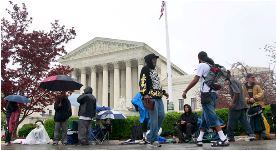
The Iron Duke and the Field Marshall
June 18, 1815
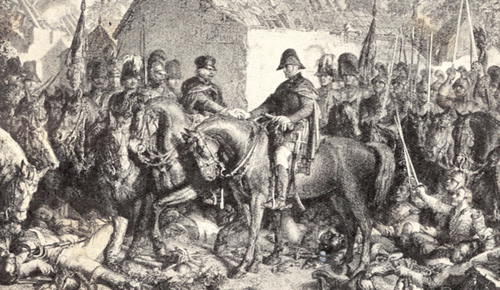
(Detail from the engraved copy of Daniel Maclise’s astonishing fresco “The Meeting of Wellington and Blücher after the Battle of Waterloo, June 18, 1815).
I never know where we will go after priming the pump with a piping hot pot of Dazbog-brand Russian Coffee. I got a fine note about the history of German Armored vehicles in fine-art prints, and that distracted me from the ongoing Climate Wars, the Santorum Campaign, and the stalking murder being clouded by claims of self-defense down in Florida. I allowed myself to vent on the sorry state of politics yesterday, and this morning, found myself taking solice in artistic renderings of monumental events.
I was thinking about the grayness of North Europe, since it is exactly the way my Arlington morning is starting out: pregnant with the prospect of rain, gray as my cashmere sweater, and pensive in no small regard. I was wandering through the archives of the mind- and searched for the war print I like best. I wound up at Waterloo, and with the example of the knock-off fine art I have actually been able to afford.
I certainly could not accommodate the original, since it is huge, and I have few walls these days with the prime real estate already spoken for. The farm was a godsend in that regard for second-tier but much-loved art.
I have a steel etching of this huge fresco, and therein lies a tale. The image leapt out at me in a second-hand store on Woodward Avenue in Suburban Royal Oak, Michigan. I cannot specify the date, except it may have been senior year in college, or about the time of the oil shock, and the price was right around $25 bucks.
I dug down into my elephant-bell low-cut jeans and pulled out my (usually) empty wallet and made a commitment to history.
The print stayed on several of my walls over the next decade, the dry fragile paper that sealed the back coming apart, the nails that kept the long silver-painted rectangle assuming a certain flexibility unintended by the original owner. When I went into the Navy (enlisted, to my surprise, to be an E5 for training purposes prior to commissioning) and lost track of it.
Eventually it migrated with the vast pile of detritus that my folks managed to the crawl space in the Little Village By the Bay where it rested until a couple years ago.
I found it there leaning on the sand floor against the cinderblock wall and tossed the poor thing into the trunk with the cast iron dwarf of whatever car I was driving at the time and brought it back to Arlington. Here I turned it over to Mr. Jimmy, my Kazak framing-and-matting guy who operates KH Fine Art Prints at the corner of Lee and Glebe in North Arlington.
“Jimmie,” I said. “Do what you can. This has been disintegrating long enough. Do what you can to save it.”
He nodded, recommended acid free backing, a couple contrasting mats and archival glass. As usual, the framing cost ten times what the original print had cost.
Jimmie did his usual nice job. In fact, it was impressive. It is now down at the Farm in the room adjacent to the one I took my astonishing fall last weekend. I don’t know precisely how old it is- I might if I was down at the farm and could go look at the spidery script under the title. I think I can reliably date my copy to one of the popular copies of the original work in the 1860s.
The work commenced in 1857, five years after the passing of the Iron Duke.
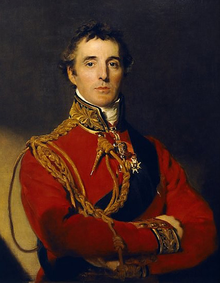
(I got a copy of this portrait of Arthur Wellesley, 1st Duke of Wellington, KG, GCB, GCH, PC, FRS at the gift shop of the Iron Duke’s residence at #1 London. It is in the back bathroom at Big PInk.)
That was the year, 42 summers after the battle that Maclise was commissioned to paint the series of frescoes in St Stephen’s Hall, but changed his mind and began the two monumental wall paintings in the Royal Gallery instead.

(Field Marshall Prince Gebhard Leberecht von Blücher, looking fierce.)
Maclise began with a cartoon that became ‘Wellington meeting Blücher’. This was finished with incredible speed and was then exhibited in the Royal Gallery at the Waterloo anniversary in May and June of 1858. The Prince Consort liked it, and was then exhibited in the Royal Academy. The cartoon was then bought by the Royal Academy and is now stored at Burlington House, having been hung for a time in the gymnasium of the Royal Military College at Sandhurst.
Meanwhile, having experimented with fresco in the Royal Gallery, Maclise decided that the commission was too difficult to undertake and resigned. If at first you can’t succeed, quit, right? But after a visit to Germany, he was converted to the waterglass method of painting as a way forward. This method employs a binder of the colors in a soluble alkaline silicate, also called stereochromy, which better resists the consequences of the British damp. The mineral plaster was prepared for him in December 1859 and Maclise began work on the fresco in January 1860, completing the heroic work in the winter of 1861.
In March of 1862 the exhibit was opened to the public, and it was a sensation. I expect the publicity is what prompted the steel etching, so I think my copy dates to some time in the Civil War years here, and naturally was pretty evocative. The exhibition caused a sensation, with visitors ‘marvelling at the fertility of Maclise’s invention’. Critics claimed the composition to be superb, and the details of military uniforms, equipment, the horses and the expressions of the characters exceptional.
Unfortunately, the second commission (‘The Death of Nelson’) did not run so smoothly, and in fact almost killed Maclise. The coincident death of the Prince Consort (and the gloom that settled over Victoria) robbed him of his cheerleader and fundraiser, and by 1864, the war chest was empty.
As Maclise finished the enormous fresco he was described as being ‘worn out with intense application’, and ‘looking like an old, old man,’ precisely the way I have been feeling lately. To a visitor he spoke gloomily: ‘Nobody cares for the pictures after they are done, or wants them, as far as I can see.’
I wanted it, and I spent about $350 to have Jimmie restore and stabilize my copy. I understand modern critics have been charitable to the somber realism of Maclise’s visual narrative. I certainly like it.
The original is something, just over 12 feet high and 46ft 8ins long. The Iron Duke is depicted meeting the Prussian Marshal Blücher at 9.15 pm on 18 June 1815. That will be the day, 97 years later, that my Sister buries Mom and Dad down in Ohio, the day after Bill and Betty’s first inurnment at the family plot in Shippensburg, PA. The Socotras were already living there on the eve of the Civil War, and would be bit-players in America’s most famous battle as the Rebels came to south-central Pennsylvania to encounter the Yankee host in the adjoining village of Gettysburg.
That is the other connection. My great grandfather Socotra, a prim shopkeeper, visited the field at Waterloo on his Grand Tour of Europe in 1903, on May 5th, almost ninety years downstream from Napoleon’s end. He would have been in his late fifties or early sixties at the time of the trip, and the last member of the family to have actually seen the Confederates in Pennsylvania. If he had any specific recollections of the field at Waterloo, he confined them to a postcard, a copy of which survived the dissolution of Mom’s fine library. His words of that day were “We are enjoying the fine sights of the great battlefield. We are all well. W.E.S.”

The strange pyramidal earth structure that dominates the field today is capped by a statue of the British Lion- hence, “Lion Hill.”
In Maclise’s vision, the two heroes of the day are meeting in the ruins of an inn called ‘La Belle Alliance’, which had been Napoleon’s headquarters during the battle. Wellington is mounted on his horse Copenhagen, and immediately beside him (right) are Lord Arthur Hill, General Somerset and the Honorable Henry Percy, with various members of the Life and Horse Guards.
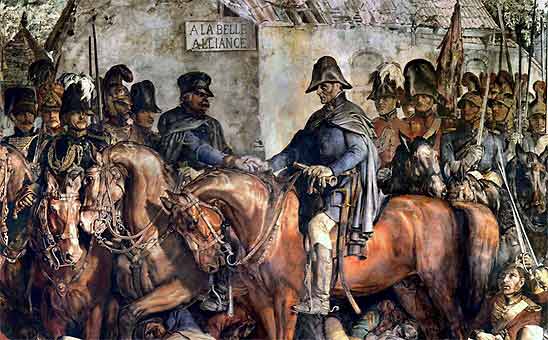
(Blücher (left) is accompanied by Gneisenau, Nostitz, Blülow, and Ziethen.)
On the white horse, with drawn sword at his shoulder, is an Englishman, Sir Hussey Vivian, who was attached to Blücher’s staff. All the details of this historical event were carefully researched. It had indeed been claimed that the two generals met elsewhere in the field of battle, and rode together to the inn.
The matter was settled by not-yet-bereaved Queen Victoria, who wrote to her daughter Victoria in Germany, asking her to question the aged Nostitz, who had been Blücher’s aide-de-camp. He confirmed the details of the meeting. One specific correction was the question of what Blücher had worn on his head. Nostitz insisted that he wore a forage cap instead of the hat and feathers with which Maclise had provided him. The artist made the change.
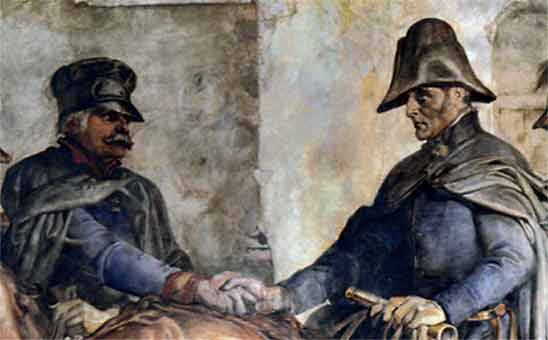
(Blucher, now with forage cap.)
Maclise painted the picture from 1859 to 1861. With the ‘Death of Nelson’ fresco that faces it across the Royal Gallery, the two works are his masterpiece.

You can see the similarities in composition between the great works, even as the two greatest heroes of the Empire have their unique differences where they lie in St. Pauls. You have been there, I know. Wellington’s tomb is on the main floor, stark and dark. He had a long career after his military triumph. Nelson, of course, died in action and is in the crypt below. His monument is light and crisp, like an enormous bit of Wedgewood china. In these two frescos they are united.
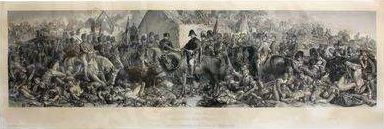
(My print of the Waterloo fresco.)
The prevailing mood is grim and tragic: there is no glorying in a military triumph. In the left foreground a French artillery officer lies dead across his gun, while beside him an English soldier has his leg bound and another is carried off.
On the right foreground, a group of wounded Life Guards, whose officer lies dead against the broken-off wheel of a gun. To the right of the wheel, a wounded officer of the Lancers is tended by a doctor. Further back, a young soldier is carried away. The attention to detail is awesome. You can identify young gallant Howard (celebrated by mad Byron in the poem ‘Childe Harold’) but also that the soldiers bearing him away include a Highlander, an Irish fusilier and an Englishman of the Foot Guard. To the right of this group, a young Flemish officer is given the last rites.
Meanwhile in the background, the routed French flee, pursued by the Prussians, in accordance with a plan agreed between Wellington and Blücher. Pushing on through the night, they drove the French out of seven successive bivouacs, and at length drove them over the River Sambre.
The Campaign was over: the French had lost 40,000 men and almost all their artillery, while the Prussians lost 7000 and Wellington over 15,000 men. So desperate was the fighting that 45,000 killed and wounded lay on an area of about 3 square miles. At one point the 27th Inniskillens were all lying dead, still in their square, and the position of the British infantry I evident from the red line of their dead and wounded.
Anyway, it is always like this, the tumbling down the years. It would only be right to get an etching of the Nelson fresco as a companion, but at some point I think I need to stop acquiring things and start giving them away.
Copyright 2012 Vic Socotra
www.vicsocotra.com
Canute and Corzine
You want to know why I am going to stop reading the NY Times and quit the Washington Post years ago? Important editorial note: before mashing the delete button, Socotra House disavows any allegiance to the strange conspiracy known at the Republican Party. Cartoon by William Warren. NetRightDaily.com
Politics are pissing me off again. Politics Is? Crap. That must mean I am feeling better, and about as concerned with the fate of the Republic as getting to the kitchen for the last cup of Dazbog-brand coffee without sprawling headfirst onto the tiles.
The President wrapped up his big Energy Trip, and I feel pretty good about it. He had some excellent photo-ops in front of the pipes for the XL Pipeline he is simultaneously blocking and claiming credit for building- you figure that one out- and at a podium in front of a Nevada solar farm that will not provide electricity to the state that partially funded it (with the Feds, and thanks for the earmark, Senator Reid!) but to the bankrupt Golden State next door.
The Left Coast Loonies have passed a regulation that stipulates the 33% of total state energy will have to come from renewable energy by 2020- a bare eight years from now.
Like King Canute attempt’s to command the tide, the California Legislature somehow has fallen into the grip of delusional thinking. Passing a law does not generate engineering miracles. That is how you get a $40,000 Chevy Volt that delivers an impressive 40 miles per charge- almost enough to get from home to work and back again. Or, dictating that all conventionally powered cars will achieve 50mpg.
Think about what you will be driving, or peddling, and how it is going to take a head-on with an ancient SUV. Never mind.
Anyway, to tout the many successes of his renewable energy plan, the President was touting “investments” (taxpayer) in “renewable” energy at Nevada’s Copper Mountain Solar 1 plant. It was built at a cost of $141 million, half of which was provided by the Feds and another $12 in tax breaks from the State. Construction of the plant involved over 300 part-time jobs, but currently only five full-time employees operate the plant, or, based on my back-of-the-napkin calculations, another one of those shovel-ready stimulus jobs that produced five jobs at around $10 million apiece.
Important note: if I included Republican idiocy for a “fair and balanced” approach to this screed, I would be broadcasting rom the Gingrich Moon Base. Every etch-a-sketch moment from the GOP is vaulted immediately into the mainstream narrative, while the President gets a pass. So relax. If the elephants ever replace the donkeys, trust me, they will be subject to far more scrutiny than Senator Reid, Secretary Chu or any of the Chicago mob that is currently picking your pocket.
In fact, among the media softballs lobbed to the President was a tribute to his commitment to solar power despite the embarrassing Solyndra affair that spent a half billion in Federal loan guarantees to the bankrupt company, which just happened to have some heavy campaign donors.
The President appreciated the tribute to his courage, and reiterated his commitment to green-energy to “decrease America’s energy costs and reduce the country’s dependency on foreign oil.”
The problem with all that is that the Boulder City had to approve a 35% rate hike to cover increased costs in 2009, and the power from the solar field is going to Southern California anyway.
Oh, the Department of Energy says that solar-PV energy will cost three and a half times more than energy from traditional sources, like coal and natural gas. I had to scratch my head on that one, since it makes my brain hurt.
If you hadn’t noticed, this really only makes sense if we are about to fry from global warming, and the real and eminent catastrophe is going to happen REAL SOON.
That isn’t selling so well, and while I listened pretty hard, I did not hear the President talk about it on this swing in which he is trying to take credit for crude being produced from wells approved by some other Administration and blocking the northern part of the pipeline that would bring more oil south from Canada.
Nevada received over $1 billion in federal stimulus funds for energy and environmental projects. Some of the other ones are as impressive as the solar array at Boulder City. The Reno Gazette-Journal recently reported that seven local windmills that cost taxpayers $1 million to install have only saved the City of Reno $2,785 in electricity costs over their 18 months of existence.
You cannot make this stuff up. But of course, when you consider who the President’s advisors are, it starts to make sense that belief in the unlikely, if not impossible, is a core value of the administration.
That hit me hard late yesterday. Wearing the knee brace that the nice people at Bethesda commanded me to wear, I was attempting to use the entire front seat of the Bluesmobile to leverage myself into a place behind the wheel.
I was listening to National Public Radio, which delivers all sorts of revealed (and unrevealed) wisdom to me all day. I heard that Jon S. Corzine, former chief executive of Goldman Sachs, a senior advisor to the President on financial and fiscal matters, campaign fund bundler for the DNC, U.S. Senator and Governor of New Jersey, might have accidentally lied to Congress.
Three times.
I am sure it is a misunderstanding, since he is a real smart guy, one of the Wall Street assholes who did very well in the process of dynamiting the global financial system. After his last job directing a financial house into the ground, he testified that he had no clue how $200 million in sequestered investor funds were miraculously transferred out of lock-box accounts and into the company’s general operating fund to try to save the enterprise.
It didn’t, of course, and thousands of little guys were left holding the bag for MF Global Holding’s malfeasance.
Governor Corzine shrugged before Congress and gave the usual Washington passive-voice line that “mistakes were made,” but of course no one was really responsible or could be held accountable.
As I wedged myself into the front of the car I was astonished to hear that internal MF memos have surfaced indicating that “JC” (which I presume is not a reference to the CEO of the Catholic Church) personally authorized the theft.
I am pretty sure that means that the Governor is guilty not only of perjury, but felony misconduct. But hey, innocent until proven guilty, after all, and the Justice Department (remember them? The ones who provided untraceable semi-automatic weapons to the drug cartels and laundered drug money to “develop sources?”) will get right on it.
If this was not so serious, I would be rolling around on the floor in hysterics.
Oh, wait, I was, just this week. It was agony, though, not laughter.
This is the sort of crap that happens when you are trying to get to something important. I was going to write about the Era of Good Feelings this morning. You might remember Jimmie Monroe’s Administration (1815-25) from your American History class in high school. He presided on a time where there were no political parties and everyone felt pretty good.
There is a lot that has changed since then, of course, because back then the voters were not expected to believe that black is white, nor that no one is responsible for anything.
As far as poor Mr. Corzine is concerned, I commend the account of his distinguished life to your attention. You will see a lot of familiar names in it. Many are Democrats, of course (duh) but people like Hank Paulson, Mr. Bush’s Secretary of the Treasury and architect of incredibly stupid (though personally profitable) policies, were close co-workers on Wall Street.
I have to say, at least behind the scenes, those smart guys certainly had their own Era of Feeling Pretty Good. Except for Jon this morning, they still are.
(Mr. Obama consults with a guy he barely knows. Photo Washington Examiner.)
Copyright 2012 Vic Socotra
www.vicsocotra.com
Emergency Services
(The new consolidated Army-Navy complex at Bethesda, home of the Walter Reed National Military Medical Center. The iconic tower where Secretary of Defense James V Forestal attempted to fly in in the center. US Government rendering.)
Ya know, I actually had an appointment with an orthopod Doc here in Arlington for yesterday- Sheila the nice lady at Commonwealth Orthopedics got it for me, but I had to cancel when I could not get a referral from my medical insurance people.
The Doc was available, and right down the road. They told me to get the piece of paper and they would be happy to see me.
Well, that led straight into the looking glass world. I tried to get a referral out of TriCare Prime, the contractor who won the contract to supervise military health care for the North East region, but no dice. They told me to contact my Primary Care Physician. I vaguely recall having got a letter about that very matter, and I think there was an actual active duty doc on the Bethesda campus who got tagged with ministering to my health needs.
I think the letter is in a folder at the office. I was not in a position to get there and find out who that might be, so I called Walter Reed (the new name for the consolidated campus at Bethesda now that the venerable Army facility is closed). The nice lady on the phone said they had absolutely no idea who “my” physician might be, so, I was left with a short list of options: either pay out of pocket for 100% or go to the place to which I had been assigned for care.
I steeled myself to go to the Bethesda ER yesterday morning. I rose early and tottered to the computer to rail about young Frenchmen of the Radical Islamic persuasion, and then headed out into the world.
It was an exciting walk down the corridor to the elevator, across the ice-slick marble of the foyer Big Pink, and over some ominously tall curbs to get to the Bluesmobile. Once I had scrunched myself into the car, I was as powerful (or more so) than my fellow motorists, and rush hour traffic was- well- rush hour on the Beltway. But not bad.
I missed the big security exercise on the sprawling campus, which has metamorphosed into a mega facility with dozens of new buildings with the consolidation of Army and Navy medical resources in the capital. Across the road is a Metro stop and the National Institutes of Health, center of gravity for all Government medical research.
It is impressive.
I got through the gate and motored around the campus. Emergency Services was located just where it used to be, though, and dismounting from the Police Car went as well as could be expected.
I was prepared to bitch my way through the whole process, but the ER on a Wednesday morning, 0800, was silent, with me being the first customer. No day laborers or long-suffering and status-ambivalent families waiting for basic health services. It still took a long time- I suspect they are not 100% manned during the hours in mid-week when people are not doing unsafe things.
In Room Two, I received periodic visits from a Corpsman, a couple Navy Nurses, commissioned officers, and my several devices beeped and chirped to keep me connected to the external world.
The Corpsman had some spectacular ink on his left arm- a Caduceus with an improbably bright red rose- and he took me on periodic excursions.
While I was being wheeled around, I saw a lovely young lady in a headscarf with deep set dark eyes in a wheelchair, waiting for her turn with the X-ray machine. She was emaciated. Cancer, I thought, or something nasty, and so young. Her young husband, a massive healthy young man, pushed her chair stoically. I was wheeled past as she took off her robe to go into the room with the big machine. She wore no bra under her think t-shirt and her chest was sunken around the pinpoints of her nipples. She made me very sad, that this should happen to someone so young and so pretty.
In the end, the very attractive dark-eyed Resident Army Physician reported that the X-rays did not indicate fracture. “That is good,” she said, and I agreed.
I waited quietly for another couple hours until she came back to inform me the subsequent review by the orthopods was complete. They can ship the Xrays around the hospital digitally these days, a cool feature, and their opinion was that surgery was not indicated. This was the same department who scoped the same knee years ago, to mixed results, so the news was good.
The Lieutenant came in to give me the discharge package, which contained a referral to the physical therapy clinic, now filled up with digital camouflage, both deep blue and desert sand versions. The Doc said: “get there early, since parking and participation are better before 0730.”
I thanked her- sincerely- for her service, and asked the Doc how I was supposed to walk from General Patient Parking, about a mile from the clinic, since that is what the problem is, and really, the reason I had not visited the campus before. We agreed there are mysteries that best left to the people who have to deal with BRAC-05 consolidation issues rather than semi-ambulatory retirees.
I was feeling pretty good when I got home, though highly stressed. I napped for a while and woke long enough to clear the office e-mail stream and called my son to ask for help over the weekend to clear some of the wreckage I cannot currently manage. The call went to voicemail, but he returned it on the way home.
I was propped in an unlikely position in my comfy brown chair, leg up. The phone was across the room, of course, and in the course of scrambling to answer, felt the knee go slightly past the maximum load-bearing point and went down for the 4th time.
Bright white light of pain in two parts: the first being the collapse, and then the impact on the rug. Lying on the floor, I looked at the sharp edges on the brass footstool in front of my chair, and contemplated what that might feel like impacting my temple.
Isn’t that how the famous actor William Holden went to the afterlife? Crap, I have to child-proof the house, I thought. Something to work on later, I reasoned, if I could get back up.
Two steps forward, one back.
i assume this will get better. Certainly hope so.
I was prepared to be mad with military medicine, but it actually was good care and the people who delivered it were responsive and professional. There just are not enough resources or professionals to make it fast or convenient.
But it is what it is. Walter Reed is a military microcosm of the larger health care system. We are all going to have to get used to that.
Copyright 2012 Vic Socotra
www.vicsocotra.com
Gath Mal Hmar
(French Interior Ministry personnel at the scene of the yeshiva shootings in Toulouse. Photo courtesy of the UK’s Telegraph.)
The murder of children is back in the news this week, not like it wasn’t last week, too.
It has happened down through the long bloody history of humankind, and in the clash of civilizations we have just observed a Citizen of France act out on his premise that school-kids are legitimate targets of deadly force.
Hey, wait. You got a minute? If there were world enough, or time, I could go on with some blather about how this is a relative phenomenon, culture norming, sensitivity, shared anger about the existence about an intrusive colonial presence, blah blah blah. Can we just use the language with some precision, and not cave into stupidity?
The “people” that do these things are overwhelmingly male. Men do these things. There is a clash of civilizations going one, if you had not noticed, or were too polite to point out in water-cooler conversation. The overwhelming number of beheadings, car bombings, IED attacks and other acts of savagery are conducted by one group of young men at war with the West.
In this rampage, this particular sick bastard is the prime suspect in the murders of three young children and a rabbi at a yeshiva in Toulouse, France.
He had gone on to shoot three French soldiers, and as of this writing is holed up in an apartment building with a Kalashnikov.
There was some thought, early on, that this might be a chapter in the continuing clash of other civilizations in France, with direct links to the Dreyfus affair, but this is much simpler. It is the act of another deluded young man who has been egged into acting out his violent religious anxiety against kids.
Whiskey Tango Foxtrot?
It makes me sick. This guy can call himself a “jihadi.” I am sensitive to his need to cloak himself in some cloud of religious fervor, and understand his desire to translate himself direct to Paradise. The very concerned media can call him that too, as if there was some honor in a struggle for murder.
Here, in this place and in this morning, let us just call him what he is, in the Syrian dialect of Arabic, a “gath mal hmar.”
Of course, animals cannot do the evil that men do. I imagine the term would be offensive to donkeys.
Copyright 2012 Vic Socotra
www.vicsocotra.com
Special Masters
(Dramatic Detroit Skyline, seen, of course, from Windsor, Ontario, in the Dominion of Canada.)
I am a political creature, as you know, and used to be comfortable in this Constantinople on the Potomac. These days, not so much. Nothing in particular seems to be working. The President seems to be surprised that people do not like higher gas prices, one of the policies advocated by our Nobel Laureate Secretary of Energy, Dr. Steven Chu, and embedded in the whole strategy to marginalize the use of coal, natural gas, and fuel derived from oil-shale and tar sands.
This is predicated on the CO2 thing- which every right-thinking world citizen supports, even if it seems a little dotty at the moment. I mean, you can’t do science by polls, can you? Or maybe you do.
As you know, I have a great deal of respect for Dr. Chu as a scientist. Maybe not so much as a politician. I have not been able to follow the twists of public rhetoric about CO2 and the price at the pump. It seems the Administration wants to have it both ways- to continue a policy that does not appear to be working while taking credit for the oil production approved by another Administration with a quite different philosophy. Oh well, we live in Lewis Carrol’s world where believing three impossible things before breakfast is necessary to be a good citizen.
On the personal level, I am confronting the issues of inevitable mortality. I thought about that, both in the context of losing Mom and Dad so abruptly, and looking up from the floor at the farm last Saturday, trying to work out how I might escape the shackles of my body and return to civilization.
I am a little down about the fact that I may have to insert myself into the merry web of the transitional National Health Care System. There is a knot above my patella that could be some snapped ligaments, or perhaps something else. I do not think anything is broken, and was willing to take things day-by-day, but I can see this is going to be a lost week altogether.
Same deal for my beloved, bedraggled City of Detroit. We have not talked about it much of late, but the Continuing Crisis is about to come to a head. The money runs out next month. Governor Snyder, the Republican reform executive of the state, has been dancing around the provisions of legislation he sponsored to permit the appointment of a appoint a Special Master to avoid the default of the largest city in the state, and once the fourth largest in the county, the Arsenal of Democracy.
Here is an entree into the weird world of a dying city. When there were 1.8 million residents of MoTown, the sprawling urban enclave had about 11,000 public servants, mostly union, of course. There are still that many on the rolls, though the beleaguered city has shrunk of less than half the population it once held.
I have written about how strange it is to drive and walk through the old town- so sad, with gems remaining amid the jetsam that has been left behind. Anyway, Mayor Dave Bing, a pro basketball star for the home-town Pistons (and later auto parts entrepreneur) replaced disgraced mayor Kwame Kilpatrick, scion of a well-connected local political powerhouse family. What brought him low was evidence that he lied about extramarital sexual activity conducted on the City’s nickel, that, and his long legal defense provided by city attorneys.
As a close observer of the Barry Administration here in Washington (and later fascination with the Mayor-for-Life’s return from prison to stand as a successful candidate for the City Council representing have-not Ward 8) I have become inured to spectacular demonstrations of public hubris. Actually, Councilman Barry is a marvel, and more than entertaining.
But Mr. Kilpatrick’s conduct was pretty amazing. After a couple stints in the slammer for corruption and then parole violation, he remains under a 38-count indictment for additional malfeasance while residing in the federal correctional facility at Milan, just outside Ann Arbor.)
(2005 Lincoln Navigator similar to that provided to Mayor Kilpatrick’s wife. Photo MyCar.com)
His first orders of business as Mayor were to secure a 2005 red Lincoln Navigator for the exclusive use of his wife (the Detroit Police Department said it was an ‘undercover vehicle,’ which of course it actually was, in a way) and to start utilizing his city-provided credit card to run up $210,000 in charges- which included spa massages and charges for fine dining. As the Motor City’s Chief Executive, he continued to support the auto industry. Court documents indicate he also leased a Chrysler Aspen SUV and a Caddie Coup DeVille.
He was ecumenical in his support for the industry, as you can see. The Aspen apparently was used at the Kilpatrick retreat in Southlake, Texas. As the scandal broke, he cut a deal to contribute $9,000 to the $210,000 credit card debt and walk away from the rest.
It is easy to pile on Kwame. He was only 31 when he was first elected and moved into the Manoogian Mansion, the city’s official Mayoral Residence. I do not know if later he wandered the halls like Richard Nixon did in the waning days of Watergate. Perhaps he sought guidance from the portrait of the other Mayor-for-Life, Coleman Young.
The city runs out of money next month. Governor Snyder is handling the situation with kid gloves. Mayor Bing is, by all accounts, an honorable man who does not need other people’s money to maintain his lifestyle. Kilpatrick and his extended family made their fortune directly from the taxpayer without any obvious benefit to anyone else in the city. Or in Texas, for that matter.
I like this one, though, as my City of Detroit slumps into a surly stand-off with Governor Snyder. It is a delicate matter, after all, and in an election year. The City Council, a bastion of taxpayer funded privilege, is loudly complaining that appointment of a Special Master will violate the principles of democracy. They are undoubtedly correct on that score. But they are distracted. The President of the Council is a fellow named Charles Pugh.
He came out of Detroit’s media market, and was a talking head on the local news before he was elected to the $76,000 year Council job. At a time when the City of Detroit faces bleak choices of bankruptcy, the imposition of some form of emergency manager or consent agreement which will permit re-negotiation of union contracts and layoffs, Mr. Pugh has announced that he is unable to pay his bills.
Detroit— City Council President Charles Pugh is facing foreclosure and says he likely will abandon his $385,000 Brush Park condominium. His personal financial struggles come as he and council colleagues fight to bail Detroit out of its own fiscal crisis.
Pugh recently said he can’t afford to pay his mortgage after taking a pay cut and leaving a high-paying TV career to run for the City Council.
“Making my mortgage payments has been a struggle for me,” Pugh wrote in an email. “I fought hard to stay in my condo because I had an attachment to it, but I can no longer afford to do so.”
“I am devoted to this city and helping us to move forward despite wage cuts and personal sacrifices such as foreclosing on my own home,” Pugh was quoted as saying. “These are the tough choices Detroiters make every day, and I am no different.”
I suppose none of us are. I will be following events in the Motor City with mild interest- there is little that can be done at this vantage point, after decades of kleptocracy. But it is illustrative, isn’t it? About how things really work?
I suppose appointment of a Special Master might address the problem. But it seems that we are having a lot of special masters these days, and only some of them are appointed to fix things that are broken. The others appear to be just along for the ride.
Copyright 2012 Vic Socotra
www.vicsocotra.com
